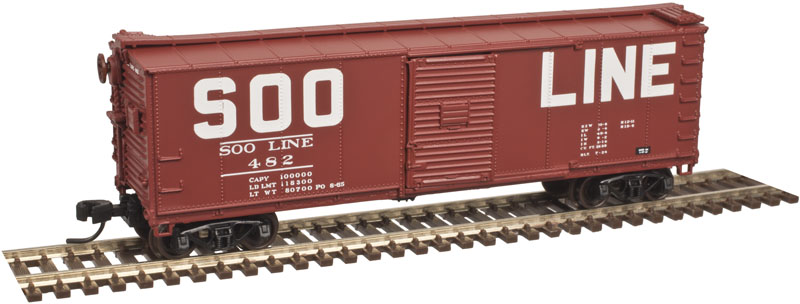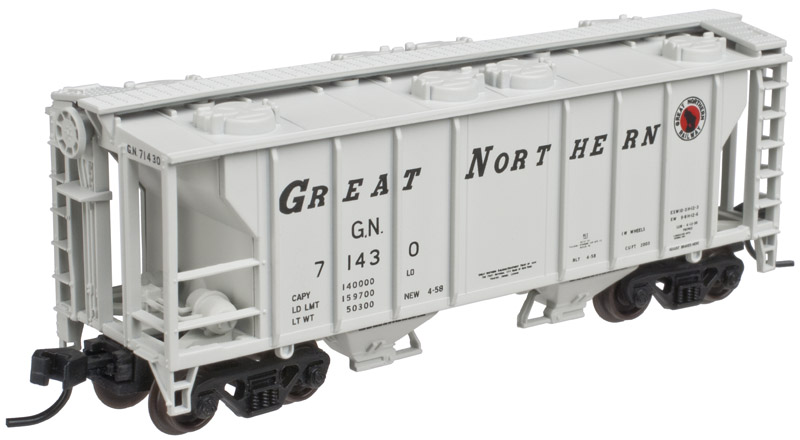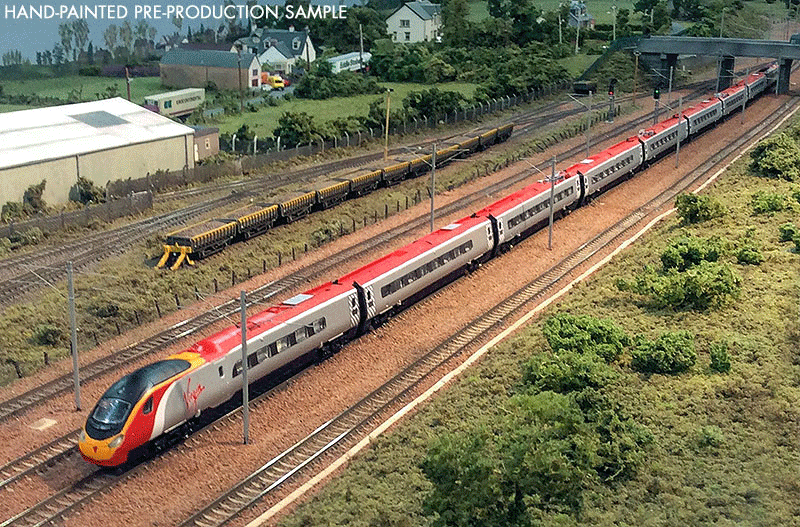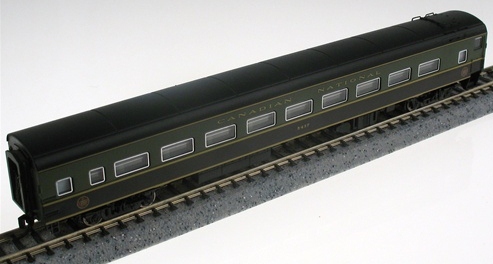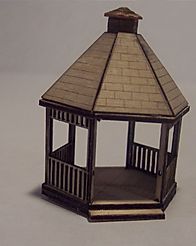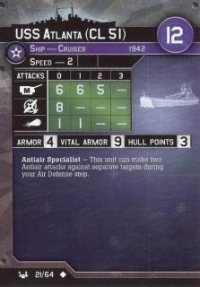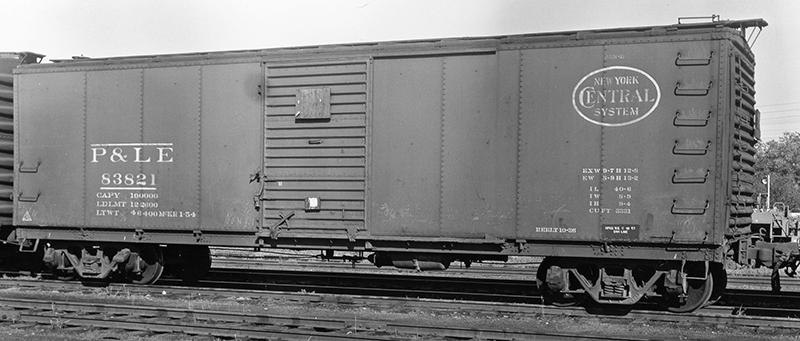Model Information: This Atlas model was announced in June 2006 with an April, 2007 delivery date. It is one of the only Atlas models to feature opening doors. This model features:
Opening Door;
Andrews trucks;
Ready-to-run;
Accurate painting and printing;
AccuMate® couplers;
Brake detail;
Highly detailed body;
Simulated wood or steel door as per the prototype;
Fishbelly or Standard underframe as per the prototype;
Different rib ends (7-8 or 5-5-5) as per the prototype;
Undecorated cars come with both simulated wood or steel door.
Prototype History: By the beginning of WWII, the majority of the classic USRA double-sheathed box cars and their clones were rebuilt with steel sides. More rebuilds followed in the late 1940s and early 1950s. By late 1948, close 14,000 of the original 24,500 USRA double-sheathed cars had been rebuilt with quite a degree of variation including the end, door and underframe. These steel side rebuilds were far more popular than their single-sheathed counterparts.
Road Name History: 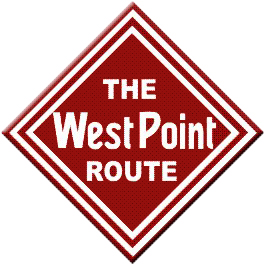 Also know as the 'Western of Alabama', The Western Railway of Alabama was formed in 1883 as a result of the reorganization of the Western Rail Road of Alabama and was converted from 5’ gauge to standard gauge in 1886. This pocket size Class 1 railroad linked Selma and Montgomery, Alabama with West Point just over the Georgia border 133 miles to the east. There they connected with their sister road Atlanta & West Point. The two roads together were referred to as "The West Point Route" and were closely affiliated with the Georgia Railroad. Locomotives from the three companies moved freely across each other’s lines.
Also know as the 'Western of Alabama', The Western Railway of Alabama was formed in 1883 as a result of the reorganization of the Western Rail Road of Alabama and was converted from 5’ gauge to standard gauge in 1886. This pocket size Class 1 railroad linked Selma and Montgomery, Alabama with West Point just over the Georgia border 133 miles to the east. There they connected with their sister road Atlanta & West Point. The two roads together were referred to as "The West Point Route" and were closely affiliated with the Georgia Railroad. Locomotives from the three companies moved freely across each other’s lines.
WoA relied heavily on 4-6-0’s in the early part of the 20th century but would later build up a fleet of seven Mikados for freight service and four Pacifics for passenger service. The biggest power on the WoA consisted of five 4-8-2 mountains, three of which were former Florida East Coast engines that were repossessed by the bank during the Depression. WoA’s first diesels were switchers from Baldwin but it was EMD that would earn all of WoA’s road service locomotives until the end.
WoA hosted Southern Railway’s Crescent Limited between West Point and Montgomery for most of that train’s history.
Western of Alabama, Atlanta & West Point and Georgia Railroad were controlled jointly by L&N and Atlantic Coast Line (SCL after 1967.) As such, Western of Alabama was one of the "Family Lines." In 1983, all of the Family Lines roads were merged to form Seaboard System. Traffic was relatively heavy and the route continues today to be an important line in the CSX system.
Text Courtesy of Bluford Shops

WoA relied heavily on 4-6-0’s in the early part of the 20th century but would later build up a fleet of seven Mikados for freight service and four Pacifics for passenger service. The biggest power on the WoA consisted of five 4-8-2 mountains, three of which were former Florida East Coast engines that were repossessed by the bank during the Depression. WoA’s first diesels were switchers from Baldwin but it was EMD that would earn all of WoA’s road service locomotives until the end.
WoA hosted Southern Railway’s Crescent Limited between West Point and Montgomery for most of that train’s history.
Western of Alabama, Atlanta & West Point and Georgia Railroad were controlled jointly by L&N and Atlantic Coast Line (SCL after 1967.) As such, Western of Alabama was one of the "Family Lines." In 1983, all of the Family Lines roads were merged to form Seaboard System. Traffic was relatively heavy and the route continues today to be an important line in the CSX system.
Text Courtesy of Bluford Shops
Brand/Importer Information: In 1924 Stephan Schaffan, Sr. founded the Atlas Tool Company in Newark, New Jersey. In 1933 his son, Stephan Schaffan, Jr., came to work for his father at the age of sixteen. Steve Jr. built model airplanes as a hobby and frequented a local hobby shop. Being an enterprising young man, he would often ask the owner if there was anything he could do to earn some extra spending money. Tired of listening to his requests, the hobby-store owner threw some model railroad track parts his way and said, "Here, see if you can improve on this".
In those days, railroad modelers had to assemble and build everything from scratch. Steve Jr. created a "switch kit" which sold so well, that the entire family worked on them in the basement at night, while doing business as usual in the machine shop during the day.
Subsequently, Steve Jr. engineered the stapling of rail to fiber track, along with inventing the first practical rail joiner and pre-assembled turnouts and flexible track. All of these products, and more, helped to popularize model railroading and assisted in the creation of a mass-market hobby. The budding entrepreneur quickly outgrew the limitations of a basement and small garage operation. Realizing they could actually make a living selling track and related products, Steve and his father had the first factory built in Hillside, New Jersey at 413 Florence Avenue in 1947. On September 30, 1949, the Atlas Tool Company was officially incorporated as a New Jersey company.
In 1985, Steve was honored posthumously for his inventions by the Model Railroad Industry Association and was inducted into the Model Railroad Industry Hall of Fame in Baltimore, Maryland. In addition, Steve was nominated and entered into the National Model Railroad Association Pioneers of Model Railroading in 1995.
In the early 1990s, the Atlas Tool Company changed its name to Atlas Model Railroad Company, Inc.
In those days, railroad modelers had to assemble and build everything from scratch. Steve Jr. created a "switch kit" which sold so well, that the entire family worked on them in the basement at night, while doing business as usual in the machine shop during the day.
Subsequently, Steve Jr. engineered the stapling of rail to fiber track, along with inventing the first practical rail joiner and pre-assembled turnouts and flexible track. All of these products, and more, helped to popularize model railroading and assisted in the creation of a mass-market hobby. The budding entrepreneur quickly outgrew the limitations of a basement and small garage operation. Realizing they could actually make a living selling track and related products, Steve and his father had the first factory built in Hillside, New Jersey at 413 Florence Avenue in 1947. On September 30, 1949, the Atlas Tool Company was officially incorporated as a New Jersey company.
In 1985, Steve was honored posthumously for his inventions by the Model Railroad Industry Association and was inducted into the Model Railroad Industry Hall of Fame in Baltimore, Maryland. In addition, Steve was nominated and entered into the National Model Railroad Association Pioneers of Model Railroading in 1995.
In the early 1990s, the Atlas Tool Company changed its name to Atlas Model Railroad Company, Inc.
Item created by: gdm on 2017-11-16 12:47:17
If you see errors or missing data in this entry, please feel free to log in and edit it. Anyone with a Gmail account can log in instantly.
If you see errors or missing data in this entry, please feel free to log in and edit it. Anyone with a Gmail account can log in instantly.


